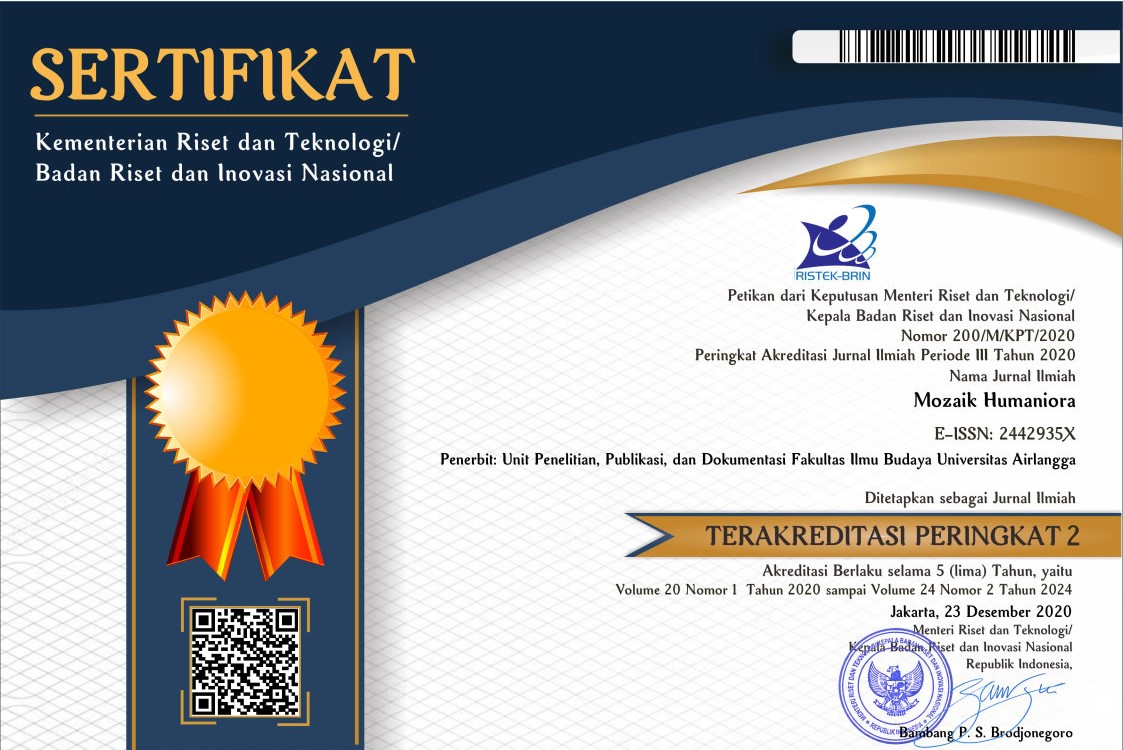Kodokushi as the Impact of Juggernaut of Modernity in Japanese Hyper-Aging Era
Downloads
This article aims to describe the phenomenon of kodokushi (lonely death) among the elderly in Japan’s hyper-aging society as a negative impact of modernity. The research is analyzed through Anthony Giddens’ juggernaut of modernity perspective. The juggernaut is a walking machine (giant panzer) with extraordinary power, which we can steer to a certain extent but is also likely to lose control and tear itself to pieces. The results show that the phenomenon of lonely death (kodokushi) in the elderly reflects the uncontrollable juggernaut of modernity. Changes in family structure, the decline in birth rates, and cultural values that Japanese people hold cause kodokushi to remain high in Japan, especially among the elderly. Elderly people who live alone without traditional family or community ties live in social isolation. In the context of Giddens' Juggernaut of Modernity, the juggernaut has lost control. The phenomenon of kodokushi reflects complex challenges. Many older people experience isolation and loneliness due to a lack of strong social ties. Culturally, the ingrained culture of not wanting to inconvenience others (meiwaku wo kakutakunai) in Japanese society is a barrier to overcoming kodokushi. Addressing this phenomenon requires holistic efforts from the government, social institutions, and society. Although efforts to overcome kodokushi have been made, understanding and dealing with these complexities is crucial in Japan's hyper-aging society.
Atoh, Makoto. 2008. “Japan’s Population Groth during the Past 100 Years.” Dalam The Demographic Challenge: A Handbook About Japan, disunting oleh Florian Coulmas, dkk. Leiden: Brill.
Befu, Harumi. 1971. Japan an Anthropological Introduction. New York: Chandler Publishing Company.
Coulmas, Florian. 2007. Population Decline and Ageing in Japan - The Social Consequences. Routledge.
Cowgill, Donald O. 1974. “The Aging of Populations and Societies.” The Annals of the American Academy of Political and Social Science 415, 1—18.
Dahl, Nils. 2020. “Governing through Kodokushi. Japan’s Lonely Deaths and Their Impact on Community Self-Government.” Contemporary Japan 32 (1), 83—102. DOI: 10.1080/18692729.2019.1680512.
Fujimori, Katsuhiko. 2010. Tanshin Kyuzou Shakai No Shougeki. Tokyo: Nihon Keizai Shinbun.
Giddens, Anthony. 1999. Runaway World: Bagaimana Globalisasi Merombak Kehidupan Kita, diterjemahkan oleh Andry Kristiawan. Jakarta: Gramedia Purtaka Utama.
———. 2005. Konsekuensi-Konsekuensi Modernitas, diterjemahkan oleh Nurhadi. Bantul: Kreasi Wacana.
Horlacher, David E. & Landis MacKellar. 2006. “Population Ageing in Japan: Policy Lessons for South-East Asia.” Asia-Pacific Development Journal 10 (1), 97—122. DOI: 10.18356/d7718c06-en.
Hosokawa, Taku. 2021. “People Dying Alone Are Going Unnoticed Longer amid Pandemic.” The Asahi Shimbun, 5 Agustus.
Ikuko, Sakairi. 2023. “Kodoku-Shi No Taisaku Hōhō Wa? Gen’in Ya Dokkyo Rōjin No Genjō Osusume No Sābisu Made Subete Kaisetsu” [Bagaimana Cara Mengatasi Kesepian? Penjelasan Semuanya Mulai dari Penyebab dan Situasi Lansia yang Tinggal Sendiri Saat Ini Hingga Layanan yang Direkomendasi]. Cocofump. https://www.cocofump.co.jp/articles/kaigo/50/.
Kamiyama, Akio. 2023. “Zōka Suru Kōrei-Sha No Kodoku-Shi to Wa? Hitori Kurashi Kōrei-Sha Ga Kakaeru Kadai No Jittai” [Berapa Jumlah Lansia yang Meninggal Sendirian? Realitas Masalah yang Dihadapi oleh Lansia yang Tinggal Sendiri]. Lifull Stories. https://media.lifull.com/crossviews/2023032765/.
Kanno, Kumiko. 2019. “Kodoku-Shi Shita 30-Dai Josei No Heya Ni Mita Itamashī Genjitsu” [Realitas Menyakitkan Terlihat di Kamar Seorang Wanita Berusia 30-an yang Meninggal Sendirian]. Toyo Keizai. https://toyokeizai.net/articles/-/285536.
Katayama, Makiko. 2023. “Kodokushi No Gen in Ya Taisaku” [Penyebab dan Penanggulangan Kodokushi]. Lifull Kaigo. https://kaigo.homes.co.jp/manual/homecare/solitarydeath/.
Koriyama, Soichiro. 2014. “Kodokushi: Apartments of Lonely Deaths in Tokyo.” IPA. https://invisiblephotographer.asia/2014/03/24/kodokushi-soichirokoriyama/.
Kotobank. “Kodokushi.” https://kotobank.jp/gs/?q=孤独死.
Kumagai, Fumie & Donna J. Keyser. 1996. Unmasking Japan Today. The Impact of Traditional Values on Modern Japanese Society. London: Praeger.
MHLW. 2008. Koureishatou Ga Ichi-Ri Demo Anshin Shite Kuraseru Komyuniti Dzukuri Kaigi (“kouritsu Shi” Zero o Mezashite) [Dewan untuk Mempromosikan Komunitas Lansia Dapat Hidup Sendiri dengan Aman (Bertujuan untuk Nol Kematian Sendiri)]. https://www.mhlw.go.jp/houdou/2008/03/dl/h0328-8a.pdf.
Nakajima, Hitoshi. 2010. Muen Shakai. “Muen Shi” 3 Man 2 Sennin No Shougeki. ed. NHK “Nihon Shakai Purojekuto. ” Tokyo: bunkeishunju.
NHK & Totuko Sasaki. 2007. Hitori Darenimo Mitorarezu. Tokyo: Hankyu Communications.
Otani, Junko. 2011. “Kodokushi (Dying Alone)-Japanese Perspectives.” Dalam Exploring Issues of Care, Dying and the End of Life, disunting oleh Sue Steele & Glenys Caswell. Oxfordshire: Inter-Disciplinary Press.
Secretariat Cabinet (Naikaku Kanbou). “Kodoku, Kodoku Kouritsu Taisaku Tantou Daijin Kara Minasama Ni Mukete.” https://www.cas.go.jp/jp/seisaku/kodoku_koritsu_taisaku/minister_message.html.
Shadanhōjin Nihon shōgaku tanki hoken kyōkai. 2020. Dai 5-Kai Kodoku-Shi Genjō Repōto 2020-Nen 11 Tsuki 27-Nichi第5回孤独死 現状レポート 2020年11月27日 一般社団法人日本少額短期保険協会 孤独死対策委員会 [Asosiasi Asuransi Jumlah Kecil Dan Jangka Pendek Jepang Komite Penanggulangan Kematian Kesepian]. https://www.shougakutanki.jp/general/info/kodokushi/news/report.pdf.
Statistics Bureau. 2021. Statistics Bureau Ministry of Internal Affairs and Communications Japan Statistical Handbook of Japan 2021.
———. 2022. Statistical Handbook of Japan 2022. https://www.stat.go.jp/english/data/handbook/index.html.
Sugiyono. 2012. Memahami Penelitian Kualitatif. Bandung: Alfabeta.
Toyama, Shogo & Hemant Poudyal. 2021. “Prevalence of Kodokushi (Solitary Deaths) in the Tokyo Metropolitan Area.” SN Social Sciences 1 (7), 1—15. DOI: 10.1007/s43545-021-00169-8.
Copyright (c) 2024 Putri Elsy, I.B. Wirawan, Pinky Saptandari

This work is licensed under a Creative Commons Attribution-ShareAlike 4.0 International License.

Mozaik Humaniora is licensed under a Creative Commons Attribution-ShareAlike 4.0 International License. Both authors and Mozaik Humaniora agree with the following attribution of journal:
1. Copyright of this journal is possession of Author, by the knowledge of the Editorial Board and Journal Manager, while the moral right of the publication belongs to the author.
2. The journal allows the author(s) to retain publishing rights without restrictions
3. The legal formal aspect of journal publication accessibility refers to Creative Commons Attribution Share-Alike (CC BY-SA).
4. The Creative Commons Attribution Share-Alike (CC BY-SA) license allows re-distribution and re-use of a licensed work on the conditions that the creator is appropriately credited and that any derivative work is made available under "the same, similar or a compatible license”. Other than the conditions mentioned above, the editorial board is not responsible for copyright violation.


















